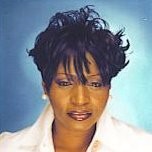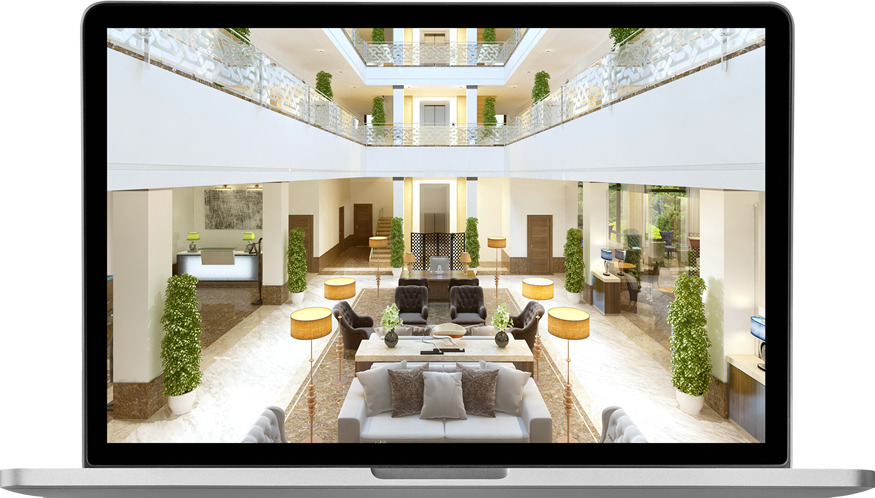Building a new website for your hotel is a lot like choosing a new food processor for your countertop. Hear me out.
As you search for the perfect appliance for your kitchen, it’s easy to get swept away by the chrome plating, bright colors (oooh avocado green!), and sleek designs. All of these details are undeniably important, but your new toy also needs to act as a workhorse on your behalf. Let’s be real, what good is your new showpiece if you can’t buzz up a killer salsa verde, pulse together a pastry dough, or break down those fibrous kale stalks for your morning smoothie?
In short, your new tool should make your life more efficient and enjoyable as its dazzling design garners envy from your friends and neighbors.
Fun Analogy, Pal. Now Let’s Get to the Point
Similarly, your new hotel website should work for you. You want your new site to impress potential guests, members of your community, and all the higher-ups at your hotel’s brand or management group. However, the functional purpose of your site is to bring in new traffic, drive revenue, and grow your business. If your site does not accomplish your property’s goals, why embark upon the long and costly site build process?
Simply put, your hotel should launch with a fully optimized website, and by baking defined conversion funnels and your calculated SEO strategy into every aspect of the site build process, you’ll hit the SERPs with a powerful revenue-driving tool at your disposal.
As you develop your new site, make sure each content and navigation element supplements your SEO strategy and guides users into your conversion funnel. In this post, I will outline four crucial steps to ensure your site launches ready to compete in the SERPS and drive revenue for your hotel. Employ these concepts during your next site build and set your hotel up for success in the ever-competitive digital landscape.
A Quick Overview
The architecture and content of a hotel website work in tandem and should be designed to drive conversions. Together, a website’s navigation structure, content pages, internal linking strategy, user experience, and keyword targeting should function harmoniously to accomplish your hotel’s unique goals.
Step One: Determine Which Pages Should Be on the Site
While this may sound obvious, the first step in building a conversion-optimized website is to determine which pages you actually want on your website. Taking time to thoughtfully develop your sitemap will ensure that each page serves a purpose and will perform a specific role in your sales funnel.
Defining Goal Oriented Pages
Different pages perform different functions in achieving your website’s unique range of goals, and your content should reflect this. As you develop your new website’s architecture and content, build in a streamlined conversion funnel, where you guide the user through the booking process. To accomplish this, you will need to create a three-tiered funnel, consisting of awareness, consideration, and action pages.
By effectively curating the booking journey for your potential guests, you will reduce bounces, create an efficient sales funnel, and maximize the revenue potential of your new website.
Additionally, Google has determined there exist five stages in the travel process, and your new website should account for this ongoing cycle as you work to build traffic and create optimized conversion funnels on your new website.
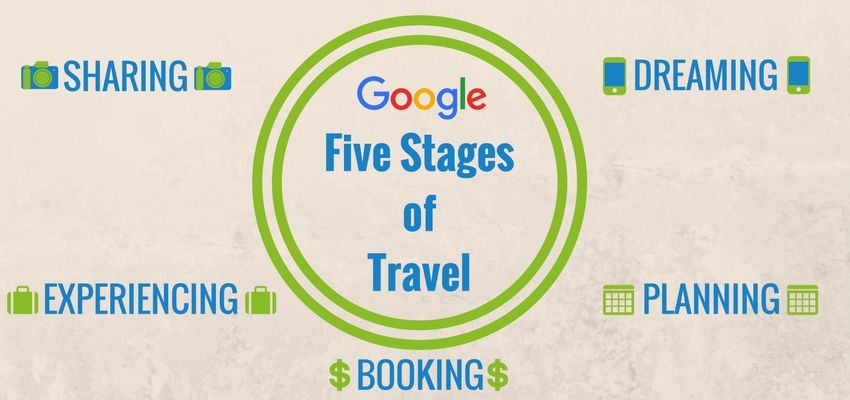
Awareness Pages: Top of the Conversion Funnel
Your awareness pages should act as a first touchpoint for potential guests, meeting planners, or brides-to-be. As people enter the DREAMING stage of travel, your awareness pages should ignite their sense of wanderlust, create great first impressions for your hotel, and ultimately make your property a viable lodging contender as users move further into the travel process.
Consider this scenario: as a Bay Area resident rides the BART to work, she may Google something like “Chicago Attractions”, find your site’s Chicago Landmarks Guide, and discover your hotel for the first time. This commuter may not even be planning a trip just yet, but when that time comes, your successful awareness page has already laid the groundwork for her PLANNING phase of travel.
Consideration Pages: Middle of the Conversion Funnel
Consideration pages target travelers actively planning their upcoming trips. Users in the PLANNING stage typically have determined destinations, have done some general research of the locales, and are consciously sorting out the logistics of their trips.
For example, a Pet-Friendly Hotels in Chicago page is a great tool to target that dog-loving Austinite planning to visit an old friend in Chicago. However, our Texan friend does not like boarding his woofer and wants to find the best pet-friendly hotel in the city. When he searches ‘best dog-friendly hotel in downtown Chicago’, clicks through to your website, and discovers your primo pet amenities, your consideration page can funnel him to your accommodations page, where he will ultimately reserve a pet-friendly room.
Action Pages: Bottom of the Conversion Funnel
As you build your new hotel website, optimize your action pages for conversion. As potential guests enter the conversion funnel, your site should guide them to your action pages. Design them for people in the BOOKING stage of travel and optimize them to drive bookings for your property.
Content like your rooms and specials pages should be easy to digest, sell your rooms in the best possible way, provide the crucial information that someone actively booking a hotel room needs to see, and include the booking links users need to reserve rooms.
How to Determine Your Sitemap
Each hotel has unique goals, selling points, limitations, and capabilities. When your new hotel website launches, its pages should reflect your property’s individual identity. Build pages that showcase your hotel’s strengths, broaden your reach in organic search, guide users through your conversion funnel, and make your hotel sound like an amazing place to stay.
Data-Determined Pages
In most instances, your landing pages can be identified through keyword research. Use a tool like Google AdWords or SEMrush to find relevant topics with high search volumes, analyze how competitive these topics are, and pursue valuable niche keywords to create awareness for and drive traffic to your site. For example, building pages showcasing a hotel’s relationship to nearby universities, major attractions, or local convention centers can drive highly-qualified sessions from users in the PLANNING and BOOKING stages of travel.
Additional Considerations
In other cases, your property’s story and defining amenities can dictate which pages need to be built. For example, if your hotel boasts a nationally-famous rooftop bar, an 80,000 square foot conference center, or on-property casino, create dedicated pages to drive traffic and revenue.
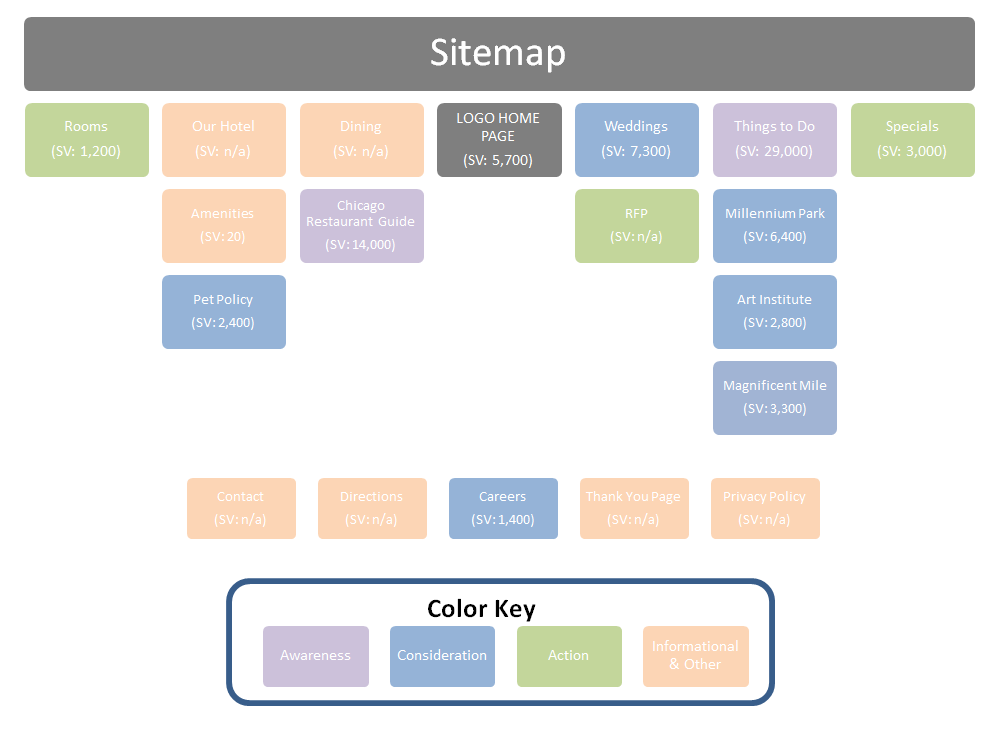
Step Two: Create a Conversion Optimized Navigation
Next, determine an intuitive, functional, user-friendly, and search optimized navigation structure. Your main navigation structure should introduce the site’s natural conversion funnel, reduce friction, and minimize the possibility of users bouncing before entering the funnel.
Seamlessly Organized Navigation
Determine where each page will live in the navigation. By creating organized, intuitive navigation, you will successfully minimize user anxiety, excessive bounces, and, ultimately, the loss of potential bookings. Don’t force users to hunt for information about your hotel’s amenities, room types, pet policy, or other make-or-break information. Instead, keep it clear, concise, and simple. Creating seamless navigation is paramount in guiding users into the website’s sales funnel.
Place your site’s most important action pages in the leftmost and rightmost positions of your navigation. People read from left to right and remember the first and last things they process (primacy effect and recency effect, respectively). Bookending your nav with your highest converting action pages – typically the rooms and specials pages – will help guide users to the bottom of your booking funnel at any given point of the session.
Intuitively Named Navigation
Intuitively name each navigation item. The verbiage of your site’s navigation should not cause confusion or doubt. While clever navigation names like “See” or “Look” might seem like a great way to brand a hotel’s photo gallery page, labeling the page “Photos” in the navigation removes thinking and second-guessing from the user experience. There are plenty of other places on your website to creatively convey your hotel’s personality. Do not get cheeky in the navigation.
For example, this hotel has gotten cutesy with its navigation, and it will create a poor user experience, marred with user doubt, uncertainty, and second-guessing. In this instance, “Perks” links to the amenities page, but a user might think it will link to a specials or rewards program page. Likewise “Experiences” links to a specials page and “Stories” sends users to a page promoting their social channels. This creates friction in the user experience. Don’t do this:

Instead, label your navigation with intuitive, easy-to-understand verbiage. When a prospective guest knows exactly what to expect, they will stay on your site, get to where they need to be, and potentially enter your conversion funnel. Your navigation should be more clearly label and resemble something closer to this:

Step Three: Create Search & User Optimized Content to Attract Users in Different Stages of the Booking Process
Creating search friendly and user-oriented content go hand in hand. As I stated earlier, each page should serve a specific purpose. Making content easy to find for users will greatly help the page perform its role in the conversion process.
Careful keyword research for each page topic reveals which co-occurring topics users are searching for and informs your which subtopics will make valuable content for your new website. Employ this data-driven approach, and your pages will perform better in search and more accurately satisfy searcher intent.
Keyword Research to Widen Your Conversion Funnel
First, determine the primary keyword for each page using AdWords, SEMrush, or any other reputable keyword tool. Find the highest volume, relevant keyword topic for which your hotel can compete.
Next, look at the related keywords & topics. High search volumes mean people want information. Including these items will help your page perform well in search for users in the PLANNING stage. Explain how these subtopics relate to your hotel, and you’ll have great, user-friendly content that guides users into your conversion funnel.
Creating Great Content
Imagine you’re a Windy City hotelier building a pet-friendly amenities page for your new website. Your page needs to tell users why your property is the pet friendliest place in town, funnel users to an action page, and leave a strong lasting impression on the traveling pet-owner. In addition to providing the dry details like the hotel pet policy, your page should also include thoughtfully-curated, supplemental content to support your SEO goals and successfully nudge users to high-converting pages.
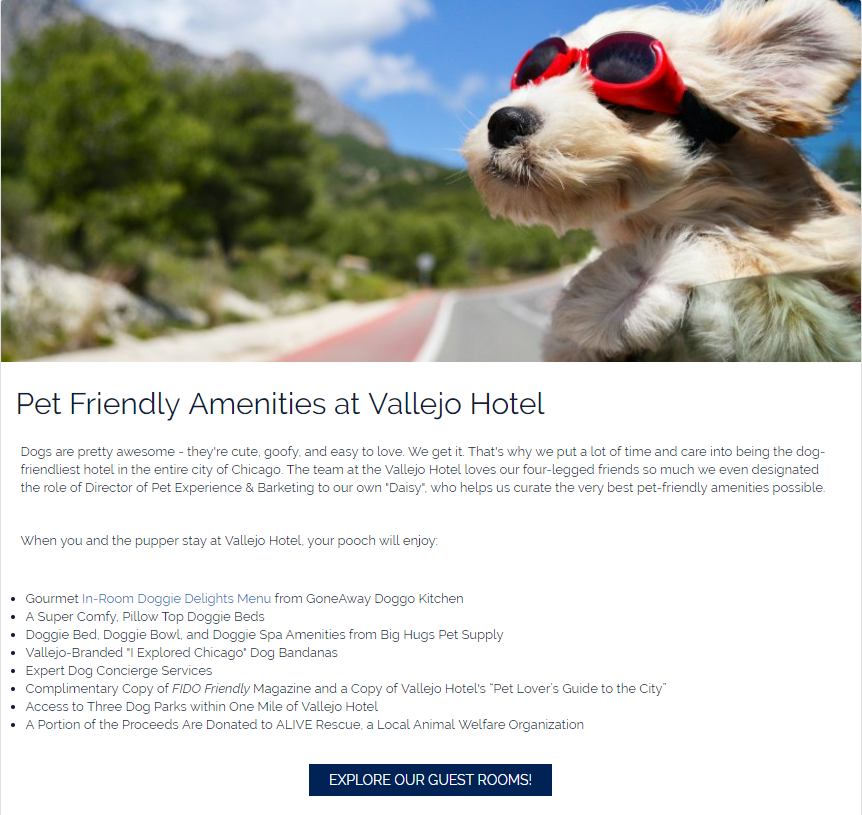
Increasing Impressions with Co-Occurring Topics
While looking for the best keyword to target for your pet-friendly hotel in Chicago page, you notice that “dog-friendly restaurants in Chicago”, “best dog parks in Chicago”, and “downtown Chicago pet stores” have high search volumes. Your pet page should address these subtopics, provide great local pet-centric recommendations, and give useful tips for navigating the city with a pupper.
After you have outlined your hotel’s pet policy and great pet amenities, provide users with the related information. By placing it after your primary hotel content, you can provide great, user-friendly information, improve your ability to rank well in organic search, and reduce the possibility of guiding the user out of your sales funnel. Beneath your property-specific content, include something like this:
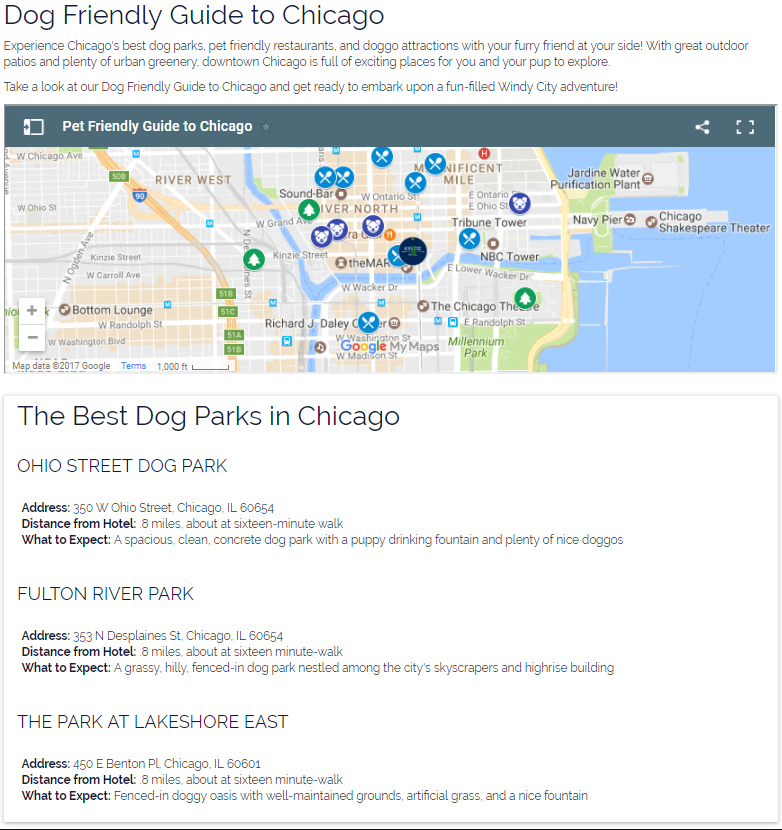
This content will not only help your page rank well for pet-friendly hotel keywords but sell your hotel as the definite authority on Chicago pet travel. By capturing traffic for these dog-related awareness keywords, you can widen the top of your sales funnel and guide more users to your action pages.
Design Your Search Optimized Page for Conversion
Take the time to create a thoughtful, conversion-driven page layout. Your page should fulfill both desktop and mobile users’ needs. The page should be fast, aesthetically pleasing, and, most importantly, easy to navigate.
A great user experience not only showcases your hotel in the fullest, but also builds digital trust, which will aid your website’s ability to guide users through the conversion funnel and drive bookings & revenue for the property. By creating a seamless, trustworthy experience, your pages will be able to effectively move potential guest through your conversion funnel.
Step Four: Internal Linking Strategy to Guide Users Through the Funnel
Your new website’s content and navigation set the stage for creating successful sales funnels. However, your internal linking tactically guides users through the funnel to your consideration and action pages. As you create content, make sure you forge defined paths that ultimately lands users on one of your designated revenue-driving pages.
Internal Linking from Awareness Pages
Make sure your awareness pages include links to consideration pages. Awareness pages like “Things to Do in Chicago” typically do not have high conversion rates, but guiding users to consideration pages puts them in a better position to reserve a room or return to your site when they transition from the DREAMING phase to the PLANNING phase of travel.
In the example below, see how the awareness page about Chicago attractions funnels users to the hotels near the Magnificent Mile (consideration) page and Mag Mile shopping package (action) page:
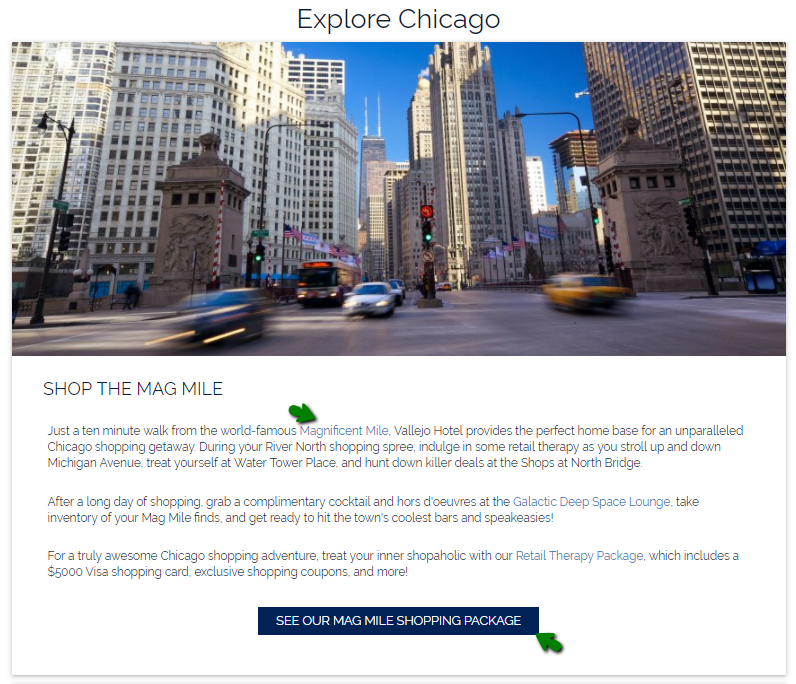
Internal Linking from Consideration Pages
From your consideration pages, include links to action pages. Linking to the RFP page from your wedding page puts the soon-to-be-wed user in a prime position to initiate the planning process. Likewise, a link to your rooms page from your “hotels near Millennium Park” page places the eager vacationer on the site’s traditionally high-converting action page.
On consideration pages, keep your linking focused. Guiding users to irrelevant informational pages, awareness pages, or your social media channels remove users from the booking funnel. Instead, guide them down to rooms, specials, and RFP pages.
Observe how this hotel’s Chicago meetings (consideration) page funnels users to the RFP (action) page after outlining the property’s unique conference space amenities, specifications, and information:
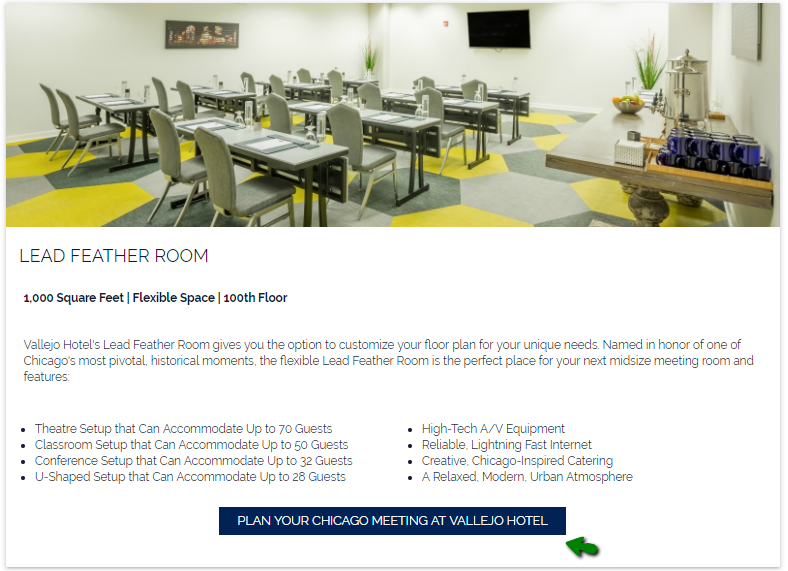
Linking from Action Pages
For action pages, include strong calls-to-action and do not link to consideration, awareness, informational, or any other wholly unrelated pages. Links on these pages should initiate the sales process, sending users into your booking engine or RFP portal.
For example, a sidebar linking to your meetings page from your suites page will pull the prospective guest out of the booking funnel, and you may lose that potential customer altogether.
Additionally, any internal links from action pages should send prospective guests to other action pages. For example, a link to the “Accommodations” page from the “Specials” page gives users the option to explore unique room types. This lateral move from action page to action page does not remove the potential guest from the conversion funnel.
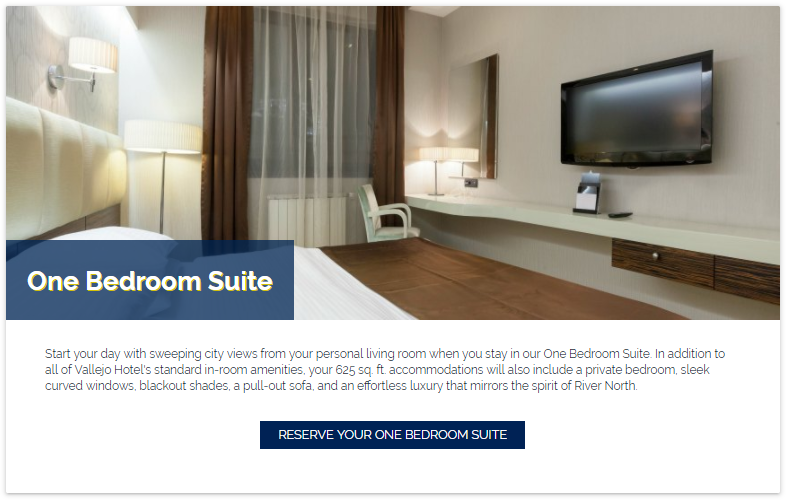
Using Internal Links to Reintroduce Prospective Guests into the Conversion Funnel
Your internal linking strategy can also guide prospective guests who have strayed from the conversion path back into the sales funnel. Sometimes site visitors navigate to informational pages from consideration pages. A strategically-placed accommodations sidebar or button on an informational page can reel that potential guest back into the conversion funnel.
During the PLANNING process of travel, prospective guests want to know if your on-site amenities will suit their specific needs. Your amenities page is a great tool to answer their questions, but amenities pages primarily act as informational pages outside the conversion funnel.
If a guest clicks from your accommodations (action) page to your amenities page through the main navigation, adding links back to the rooms page will help guide that person back into the conversion funnel. The strategically placed text and button links in the example below show an easy way to nudge visitors back on the path to conversion.
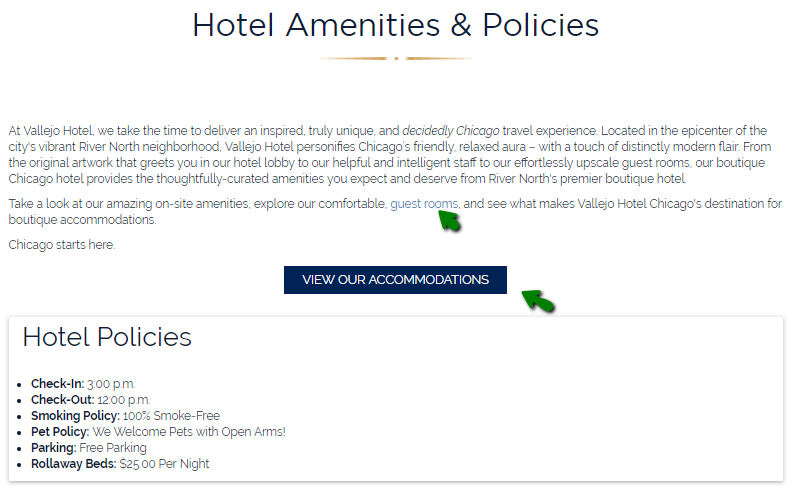
Your thank you page is great place to direct prospective guests who did not book back into your sales funnel. If a user lands on a thank you page after checking rates, guide them back to your highest converting action content to recapture that potential revenue.
In this example, the user lands on a thank you page upon clicking into the booking engine to check room rates and availability. In the event the prospective guest wants to learn more about the rooms before making a transaction, a funnel-minded thank you page can put user back on the path to conversion.
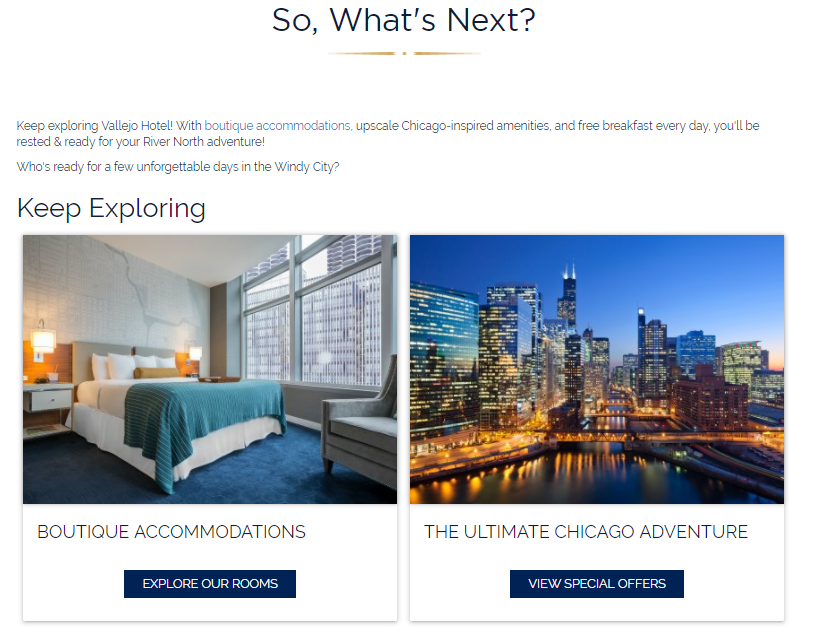
So, How Does This Affect Your Hotel?
In conjunction, all of these tactics work together to yield tangible, real-world results for your hotel. By targeting the right keywords, your website will earn targeted impressions, drive qualified traffic from searchers in different stages of travel, and generate revenue for the hotel.
Forecasting Quantifiable Success
Using your keyword research, industry trends, and your ADR, you can predict how much potential revenue your new site can generate. I’ll use the homepage of a fictional downtown Chicago property, who we’ll call the Vallejo Hotel, as an example.
Keyword research shows that, on average, the hotel generates 16,000 branded impressions per month and that its homepage can rank on the first SERP for roughly 84,000 non-branded hotel searches per month. Using these numbers and average industry conversion rates as our baseline we can predict that:
- We can earn clicks from 2% of these 100,000 searches, which equates to 2,000 organic sessions per month.
- Roughly three percent of these 2,000 searchers will ultimately reserve a room, which equates to 60 unique bookings.
- If the hotel typically sees an average length of stay of 1.8 nights, the content and keyword strategy for this page will yield 108 room nights per month.
- With an average ADR of $125.00, these 2,000 homepage sessions will generate an average of $13,500 in direct booking revenue each month.
Furthermore, as you build more content and drive more traffic to your site through your ongoing SEO campaign, you’ll be able to consitently and sustainably grow your revenue.
But first, you need to set your website for success from the start. To ensure your shiny new website drives qualified traffic, generates scalable revenue, and lives up to its full potential, you must first make some strategic SEO decisions and start crafting effective conversion funnels at the very start of the site build process. As you start planning out your awesome new website, make it a point to:
- Target searchers in different stages of travel as you determine which awareness, consideration, and action pages will exist on your site to create website’s conversion funnel.
- Create an intuitive, clearly labeled navigation structure that complements the goals of your hotel’s conversion funnels.
- Create search engine optimized content pages that target multiple keywords, create a great user experience, and play dedicated roles in your website’s sales funnel.
- Build a strategic internal linking structure moving prospective guests down the sales funnel to your high-converting action pages.
In short, when you build your website to attract qualified visitors, deliver thoughtfully-created content, and form a seamless sales funnel, your website will perform well in search and act as a fine-tuned digital marketing machine.
To learn more about building a search and conversion optimized website for your hotel, get in touch with the friendly and talented Blue Magnet team!



